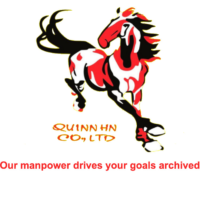

The Hidden Financial Landscape: 11 Accounts Beyond the Balance Sheet for Global Workforce Management
- trienkhaiweb
- 6 May, 2024
- 0 Comments
As companies like Quinn Vietnam Manpower navigate the complexities of global workforce solutions, it’s crucial to understand that a company’s financial health isn’t solely reflected on its balance sheet. Numerous accounts play a pivotal role in operations and long-term success, even if they don’t make a direct appearance on this traditional financial report.
1. The Power of Manpower: Dividend Accounts and Workforce Investment
Dividends, often distributed to shareholders as a reward for their investment, symbolize the company’s profitability. While not on the balance sheet, they demonstrate how a manpower provider like Quinn Vietnam Manpower can leverage its success to incentivize and retain valuable stakeholders. This is just one example of how a company’s financial story extends beyond the balance sheet.

2. Unveiling the Workforce Engine: Off-Balance Sheet Assets and Liabilities
Off-balance sheet items, such as operating leases for office space or contingent liabilities tied to potential labor disputes, offer a glimpse into the dynamic nature of global manpower management. These elements, while not explicitly stated on the balance sheet, can significantly impact a company’s financial standing and its ability to provide reliable workforce solutions.
3. Nurturing the Talent Pipeline: Research and Development (R&D) Expenses
R&D expenses are the lifeblood of innovation, crucial for companies like Quinn Vietnam Manpower to stay ahead in the competitive global labor market. While these costs are typically expensed immediately, they represent an investment in the future workforce, leading to improved recruitment strategies, enhanced candidate screening, and streamlined placement processes.
4. Building a Reputation of Trust: Goodwill and Brand Value
Goodwill, the intangible asset tied to a company’s reputation, is a critical factor for attracting both clients and top-tier manpower talent. Quinn Vietnam Manpower’s brand value, cultivated through ethical practices and successful placements, serves as an off-balance sheet asset that fosters long-term relationships and bolsters its position in the industry.
5. The Workforce Lifecycle: Depreciation and Amortization
While seemingly mundane, depreciation and amortization expenses reflect the wear and tear on tangible and intangible assets – from office equipment to software used in talent acquisition. These expenses, while not on the balance sheet itself, remind us of the ongoing investment required to maintain a robust workforce management infrastructure.
6. Strategic Partnerships in the Manpower Landscape: Equity Method Investments
Equity method investments, where a company like Quinn Vietnam Manpower holds significant influence in another entity, offer insights into potential growth strategies and collaborations within the broader manpower ecosystem. These investments, while not fully consolidated on the balance sheet, can unlock new markets, talent pools, and service offerings.
7. Navigating Workforce Uncertainties: Contingent Assets
In the world of manpower, contingent assets could be potential government contracts or pending recruitment deals. While not recorded on the balance sheet due to their uncertain nature, these assets highlight the strategic foresight required in workforce planning and the potential for future revenue streams.
8. Fueling the Manpower Engine: Operating Expenses
From recruiter salaries and marketing campaigns to office rent and utilities, operating expenses reveal the day-to-day costs of running a global manpower company. While these expenses are on the income statement, they underpin the ability of Quinn Vietnam Manpower to connect businesses with the skilled workforce they need to thrive.

9. Investing in the Future Workforce: Prepaid Expenses
Prepaid expenses, such as pre-paid advertising for job postings or training courses for future manpower recruits, represent an upfront investment in talent acquisition and development. These expenses, while initially assets on the balance sheet, demonstrate a commitment to building a qualified and adaptable workforce.
10. Building Trust with Clients: Unearned Revenue
Unearned revenue, such as fees received in advance for manpower placement services, reflects the trust clients place in a company like Quinn Vietnam Manpower. While a liability on the balance sheet initially, this revenue is earned over time as the company fulfills its commitments, showcasing the importance of delivering on promises in the manpower industry.
11. Workforce Optimization: Gains or Losses on Asset Sales
If Quinn Vietnam Manpower sold an office building or a piece of recruitment software, the resulting gain or loss wouldn’t appear on the balance sheet. However, this transaction would speak to the company’s ongoing efforts to optimize its operations, reallocate resources, and ultimately provide the most efficient and effective manpower solutions to its clients.
Quinn Vietnam Manpower: Beyond the Balance Sheet
By understanding these 11 hidden financial factors, we gain a more comprehensive view of a company’s financial health and strategic approach to workforce management. This knowledge empowers companies like Quinn Vietnam Manpower to make informed decisions, build sustainable growth, and continue to play a vital role in connecting businesses with the global talent they need to succeed.
Related articles
Conquer Procrastination and Boost Productivity with Quinn Vietnam Manpower
Quinn Vietnam Manpower understands the challenges businesses face in today’s dynamic landscape, and procrastination amongst employees can be a significant hurdle to achieving peak performance. In this article, we delve deep into the phenomenon of “procrastiworking,” explore its underlying causes, and provide actionable strategies to overcome it and unlock the true potential of your workforce…
Conquer the Chaos of Busy Work with Quinn Vietnam Manpower
Unlocking Productivity and Empowering Your Workforce in 2025 In today’s dynamic business landscape, companies face a constant barrage of distractions and administrative tasks that hinder productivity and stifle growth. This “busy work” epidemic, characterized by endless meetings, inefficient communication, and constant context switching, prevents employees from focusing on meaningful work and achieving their full potential….
Conquer Time Management Challenges with Quinn Vietnam Manpower
In today’s fast-paced business world, effective time management is more critical than ever. For managers in Vietnam, juggling multiple responsibilities and navigating a dynamic marketplace can make efficient time utilization a significant challenge. This is where Quinn Vietnam Manpower comes in. We not only provide top-tier manpower solutions to help your business thrive but also…
Conquering the Post-Holiday Email Avalanche: Tips for Success with Quinn Vietnam Manpower
The holidays are a time for relaxation and rejuvenation, a chance to step away from the daily grind and recharge. But the joy of returning to work can quickly sour when you’re faced with an overflowing inbox. For businesses, especially those relying on efficient communication with partners like Quinn Vietnam Manpower, tackling this digital mountain…
Cultivating a “No Blame” Culture for Optimal Manpower Performance
In today’s dynamic business environment, fostering a positive and productive work environment is crucial for attracting and retaining top manpower. Quinn Vietnam Manpower recognizes the detrimental effects of a blame culture and offers guidance on cultivating a “no blame” environment where employees thrive and contribute their best. This approach aligns with the evolving needs of…
Data Analytics: Supercharging Project Management
In the fast-paced world of project management, staying ahead of the curve is no longer a luxury, it’s a necessity. Forward-thinking teams recognize the power of data-driven decision-making, and in 2025, this trend is only accelerating. This is where Quinn Vietnam Manpower comes in, providing the expertise and manpower solutions to leverage the superpowers of…








